The most glorious victory of the Russian fleet
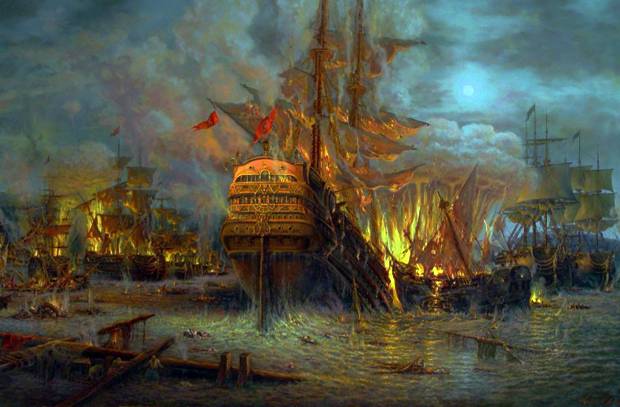
«Fleet - glory! It’s good for the homeland! ” - with these words he described General-General A.G. Orlov, the victory of the Russian fleet in the Battle of Chesmina in his report sent to Empress Catherine II on June 27, 1770. This victory was included in naval textbooks. stories all over the world. Chesma marked the exit of Russia into the ocean.
The road to this brilliant victory was not easy. It was the second year of the Russian-Turkish war (1768-1774), the first Catherine's war for Russia's access to the Black and Mediterranean seas. The Ottoman Empire, which has already lost its former strength and title of mistress of the Black, Red and Mediterranean seas, with enviable persistence resisted the emergence of the Russian trade and even more naval flag in the waters of the southern seas, and especially the Black Sea. Russia did not have access to the Mediterranean and Black Sea trade and any stable strong maritime ties with southern Europe. The Turks tightly blocked for the Russian fleet the Bosphorus and the Dardanelles, which the Ottoman rulers traditionally considered the "property" of their empire. The extortions of the Turkish authorities for the transportation of Russian goods on the ships of the Ottoman Empire were so huge and arbitrary that they made for Russia maritime trade in the southern seas almost impossible. Trade, manufactory production, agriculture of the central and southern regions of Russia literally suffocated without secured access to the southern seas provided by the navy.
It is worth noting that in the large territories between the Black, Azov and Caspian seas, as well as in the foothills of the Caucasus, there were many Turkic-Kalmyk tribes. They were the subject of constant interest of Turkey and Iran. Had these nationalities come under their dominion — and the coasts of the southern seas, so necessary for Russia, would have become even more distant.
It is also worth remembering that only a century ago, during the reign of Yuri Khmelnitsky in Ukraine, who betrayed his father’s work, in the seventies of the seventeenth century, the whole of Right-Bank Ukraine, albeit for a short time, became part of the Ottoman Empire. This was the result of the anti-Russian policy of some Cossack elders who entered into an agreement with the long-time enemies of the Ukrainians - the Turks, the Polish-Lithuanian nobility and the Crimean khans. These agreements have sunk into oblivion together with petty intriguers who fought against the “Muscovites” by any means, but the memory of the garrisons of the Janissaries, who stood on Podolia, remained fresh during the 18th century.
A serious threat to the south of Russia was the Crimea. Its rulers, the Bakhchisarai khans of the Girey clan, were direct descendants of Genghis Khan. For centuries, they were allies of the Turks, Lithuanians and Poles, and sometimes even of distant northern Sweden, in their struggle for Russian lands and the weakening of Russian statehood. From the 15th century, the vassals of Turkey were terrorized by the Crimean khans with constant raids, which had not yet recovered from the Yerdin yoke, the Muscovite state. For four centuries in a row Russian captives filled up numerous rows of slave-rowers, and thousands of Russian girls sold in the eastern slave markets gave birth to the new subjects of the Turkish sultans.
Russia could no longer tolerate this robbery. Russian people from time immemorial differed responsiveness to someone else's grief. In Russia of the 18th century, the tragic fate of the Slavic and Orthodox peoples was perceived as the legacy of such a hated Horde sovereignty, to destroy which "the Lord entrusted to the Russian people."
Peter the Great and his successors perfectly understood these feelings of kindred nations and more than once threw Russian regiments to the south, to the Black Sea. However, the success of individual military campaigns could not radically change the geopolitical situation. The Ottoman Empire was still strong, and France, England, Austria and Sweden did not need the appearance of a powerful Russian fleet in European seas, and the Russian ruble in the South European markets.
By the end of the 18th century, our country itself was tasked with the history — despite Eastern and European resistance — to finally reach the Black and Mediterranean seas, the Atlantic, and thus restore the centuries-old ties of Eastern Slavs with the Mediterranean peoples, Southern and Western Europe interrupted by the Horde invasion.
All these factors led to the perception of all wars with Turkey in the 18th century as popular, and, moreover, having a certain religious aspect. To protect the south of our country and achieve access to the straits of the Black Sea from two sides, from the Danube to the Bosphorus, and across the Mediterranean to the Dardanelles - this was the plan of St. Petersburg in this Russian-Turkish war. The decisive empress Catherine II planned, as she declared, "to burn the Ottoman Empire from four sides." In this case, the most important role was assigned to the grand expedition of the Russian fleet from the Baltic to the Dardanelles.
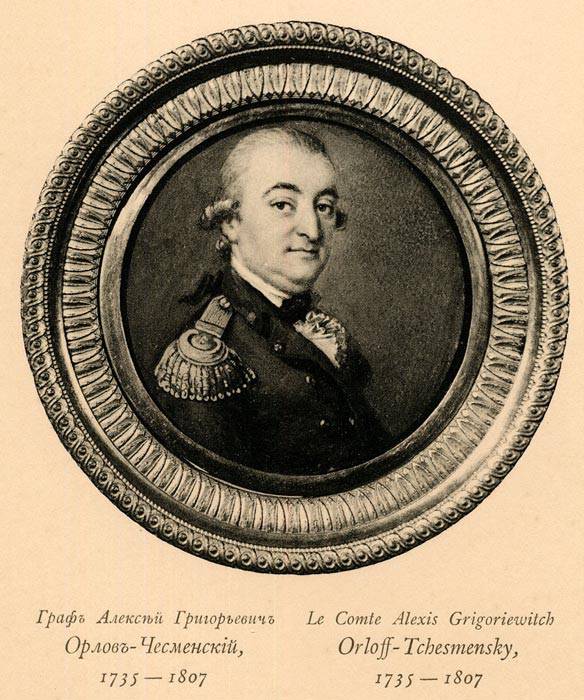
The first squadron, which set off on an archipelago expedition, was commanded by a fearless and at the same time cautious admiral G.A. Spiridov. General management was carried out by General-in-Chief A.G. Orlov, brother of the famous “nobleman of chance” Grigory Orlov.
By the beginning of the expedition, Grigory Andreyevich Spiridov turned 56 years. 40 of them he spent on ships. Consistently, during 1769-1774, four more Baltic squadrons (two dozen ships of the line, six frigates, a bombardier ship and about thirty other ships — more than fifty pennants) followed the Spiridov squadron — more than fifty pennants seas. During these complex months-long trips, the Russian sailors had to face not only the forces of the storms of the treacherous Atlantic, but also the watchful attention of the British, who jealously followed our ships through Pas de Calais, the English Channel and Gibraltar, and outright hostility with side of the French and Spaniards, who tried to prevent the transfer of our ships. Western Europeans certainly did not like the emergence of a new powerful naval force in the face of the Russian fleet in their waters. However, without taking into account the discontent of the Western powers, by the summer of 1770, the Russian squadrons appeared in the rear areas of the Ottoman Empire - in the Eastern Mediterranean, Ionian and Aegean seas.
By the end of winter 1770, the Spiridov 1 squadron approached the shores of the Greek Peninsula Moray (Peloponnesus) belonging to the Turks and landed troops. In February, the Russian landing troops, supported by the rebel Greeks, seized the cities of Mizitra (Mystras) and Arkady. At this point, 2-I squadron of Rear Admiral John Elphinstone, an experienced commander of English origin, serving the Russian fleet, approached the Greek shores. In parallel with the landing of assault forces, the Spiridov squadron deployed operations against the Ottoman fleet in the coastal waters of the Moray Peninsula. But it should be noted that, despite a fairly successful start, General-Chief Orlov, who led the general actions of the Russian squadrons, had grounds for alarm. In the course of planning an operation in Petersburg, the stakes were made on a general uprising and the support of the Greeks. Indeed, the Greeks on the islands, where Russian squadrons landed troops, joined our troops in large numbers and readily marched on the Turks, but during the battle at the first danger they often fled, leaving the small Russian troops to the enemy.
The remoteness from the Russian shores, the absence of any of their own bases and the extremely low reliability of the Greek support prompted A.G. Orlov and admirals make a risky, but the only correct decision. The Ottoman fleet had to be given a general battle ... and to win, because there was no other option for the Russian squadrons.
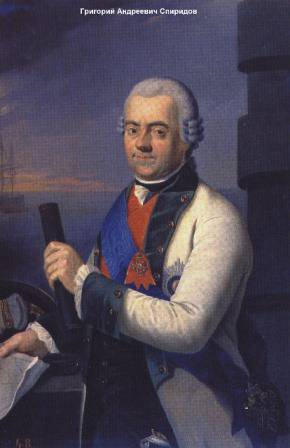
Offensive tactics paid off in full. April 10 1770 th brigade leader artillery I.A. Hannibal after a short but tight blockade seized the city of Navarin and the eponymous fortress on the coast of the Ionian Sea. Note that Hannibal, taking this fortified item, made quite accurate schemes of the bay. Subsequently, during the famous 1827 battle of Navarino, these schemes proved extremely useful for Russian naval commanders, and helped to win a new victory over the Turks.
It should be remembered: the Russian fleet in 1770, the enemy was experienced and strong. The Algerian Real Bay (Vice Admiral) Hassan Jezairly Bey, a well-known and successful naval commander, commanded the Turkish fleet. The nominal commander-in-chief of the Turkish Navy was Husameddin Ibrahim Pasha, who bought a Kapudan-Pasha post in the spring of 1770 of the year. He did not understand completely in the maritime business, but he loved the prize money. Ibrahim Pasha quickly realized that the Russian ships in the Mediterranean was the will of Allah, and after a couple of clashes with the "northern devils" he had witnessed, he considered it best to go to the Dardanelles to build up the coastal batteries. In the current squadron, he no longer showed up and did not intervene in command issues.
It is worth remembering that the crews of the Turkish ships were recruited from the inhabitants of the coastal areas of Turkey, who had a good command of the boarding and had excellent skills in working with rigging. The Ottoman fleet had excellent artillery. One of the participants of the campaign - captain-commander S.K. Greig, who later became an illustrious Russian admiral, wrote tables in his diary listing the ships and the number of guns on each of them, in our and Turkish squadrons on the eve of decisive battles. If Russian battleships were armed with 66 guns (except for Svyatoslav, armed with 80 guns), then the flagship Turkish ship carried 100 guns, another battleship - 96, four more - 84, one - 80, two - 74, seven - on 60, the rest were set from 40 to 50. According to Greig's testimony, "the Turkish battle line had an excellent device." The Turks, after the Battle of Navarino, before Chios and Chesma against the Russians had 16 battleships, 6 frigates and more 60 caravels, a galley (they were served by Russian rowers-slaves) and firefighters. They had more 1400 guns.
Squadron G.A. Spiridov counted after connecting 22 on May 1770 of the year with the arriving 2 squadron of 9 battleships, 3 frigate and around 20 other ships and transports. Its general armament was about 740 guns. In artillery, the enemy was almost twice as good.
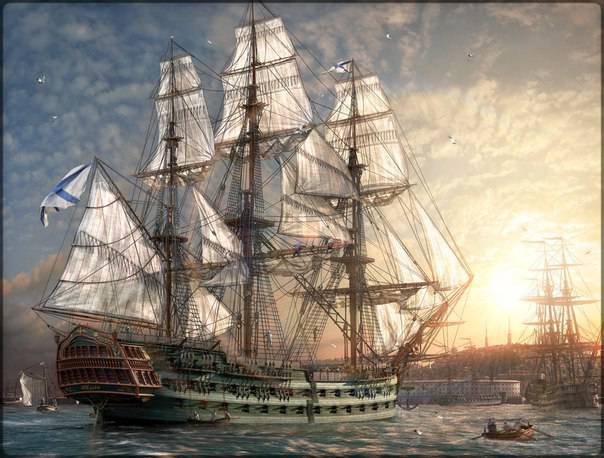
But do not forget at the same time that a significant part of the crews of Turkish ships - up to one-third, or even more, were Greeks who hated the Turks. The inhabitants of the islands and coasts, hereditary skilled navigators, they regularly fulfilled their duties when they were hunting for individual European privateers (ie, privately owned, specially armed to operate on sea lanes) ships or robbed merchant (including Russian) vessels. Under Chesme, as before under Navarin and Chios, they broke. The Ottoman teams, torn apart by ethnic and religious contradictions, were confronted by a previously unified, cohesive force - the sailors of the Russian navy, who, as the Turkish chronicler wrote, "were probably transferred from the country of Muzhikistan, from the sea, called Baltic, through the Strait of Gibraltar straight into Blessed Limits are nothing but magic. Maybe by the will of the Most High. "
In May-June 1770, our squadron made attempts to get close to the main Turkish fleet forces. Alexei Orlov and his brother Fyodor, who also became a member of the expedition, hoping to earn loud glory and high rank, send reports to St. Petersburg indicating that the enemy is not fighting. So, 26 of May 1770 of the year F.G. Orlov informs Catherine II that he and the Russian squadron are chasing the Ottoman fleet, which “runs after a couple of mistakes headlong.” 20 June 1770 of the year the empress sent a similar report that the enemy is running everywhere, hiding between the islands of the Aegean archipelago. It is worth noting that the Orlov brothers did not quite correctly assess the situation, explaining the maneuvers of the Ottoman captains solely by the fear of a battle with the Russians. Do not forget the facts of the desperate courage of the Janissaries displayed by them in battles with the Russians, commander Recall that Malakhov’s kurgan in 1855 seized the Algerian Zuava regiment with a powerful assault, or the ingenious trap Peter the Great of the Prut campaign of 1711 of the year did not leave a single loophole to the Russian army. Ekaterina Alekseevna even had to sacrifice personal jewels in order to help the great spouse out of the desperate situation in which he found himself with his army. No, the Turks were brave, skillful and treacherous warriors. Therefore, the victory over them is worth a lot. Moreover, the data of the Turkish chronographs of the end of the XVIII century testify that the Algerian Real Bay had a cunning plan to destroy the Russian squadron. The data of the Turkish chronographs of the end of the 18th century testify that the Algerian Real Bay had a cunning plan to destroy the Russian squadron. He realized his insidious plan gradually, imperceptibly tightening the ships scattered across dozens of Mediterranean harbors, to the channel and the island of Chios off the coast of Asia Minor Turkey. Why then did the sultan's naval commander select this particular area as a trap? This is due to a number of reasons.
It has already been said that the whole insular and part of mainland Greece were swept by the rebel movement. According to the Turkish chronicles, not only Greek, but even Ottoman settlements on the Aegean coast of Asia Minor were covered with mass discontent. In fact, the flame of rebellion from the colonies spread to the metropolis. Chesma belonged to places relatively quiet and calm on the Anatolian coast, far from military operations.
Then Catherine II sent the fleet to “raise” not only Greece, but also the Levant, i.e. all Eastern Mediterranean. It is known that A.G. Orlov was in active contact with influential Christians of Lebanon, with Arab sheikhs of Syria and Palestine, who sought to pursue an independent foreign policy. Egyptian ruler Mameluke Ali-bei al-Kabir, by 1770, he firmly adhered to achieving independence from High Porta, he had not paid tribute to Istanbul for two years and did not remember the name of the Ottoman Caliph-Padishah - the head of the righteous, which meant a daring challenge to the sultan. Abkhazian descendant, Ali-bei himself declared himself an independent sultan of Egypt, the ruler of the White (Mediterranean) and Red Sea. He captured the Hija region in the Arabian Peninsula and entered into an alliance with one of the Arab sheikhs of Palestine, Dager, who later withstood the onslaught of Napoleon himself.
Ali-Bei insistently assured AG Orlov, that his homeland, Abkhazia, far from Egypt, wants to surrender to Russian protection, and he, the ruler of Egypt, is Russia's best and most faithful friend! St. Andrew’s flag on the pyramid of Cheops, Russian sailors in Cairo and Alexandria, in Beirut and Palestine, where there is a mass of Christian Arabs, was a bad dream for Ottoman rulers. In order to prevent this, the Sultan and Kapudan Pasha decided to divert the Russian fleet from the Egyptian coast at any cost, try to “wind” it in the narrowness of countless straits of the Aegean archipelago, substitute coastal batteries for fire, destroy Russian landing forces on the Anatolian coast, if they landed . But already on their own land to fight the Turks were able. P.A. Rumyantsev, and A.V. Suvorov. However, A.G. Orlov more than once "stumbled" about the seaside fortresses in Greece, which were defended by the janissary garrisons, with even stubbornness and some special tenacity that amazed him.
And two more circumstances noted by contemporaries in the documents. Firstly, Hassan Bey, because he deliberately lured Russian sailing ships to mountainous small islands, because here they had to “lose the wind”, maneuverability, therefore, it would be relatively simple booty of experienced and cruel boarding teams that were not dependent on the wind, rowing galleys , which in the designated area was concentrated about two dozen. Secondly, in the arsenal the Turks from the middle ages had such a powerful weaponas firefighters. In the summer of 1770, Hasan Bey had no less than a dozen firewalls packed with gunpowder, oil, and the famous “Greek fire”.
So, the end was coming. 23 June 1770, the Russian squadron overtook the Turkish fleet, anchored in the Strait of Chios, near Chesme Bay and the eponymous fortress on the coast of Asia Minor. While Orlov and Spiridov were refining the details of the battle formation until the next morning on 10, the wind gradually calmed down. But the successful wake along the wind helped our ships, although more slowly than Spiridov wanted, but steadily approaching the Turkish battleships that had risen (or perhaps were deliberately delivered by Greek pilots) so poorly that the Turkish fighting galleys from our ships. And here the Russian sailors performed a maneuver of amazing precision and coherence. With the wind weakened by this time, our squadron was able to turn overboard to the Ottoman ships and to open aimed and very accurate fire from half the cable ship, i.e. from about 90 meters!
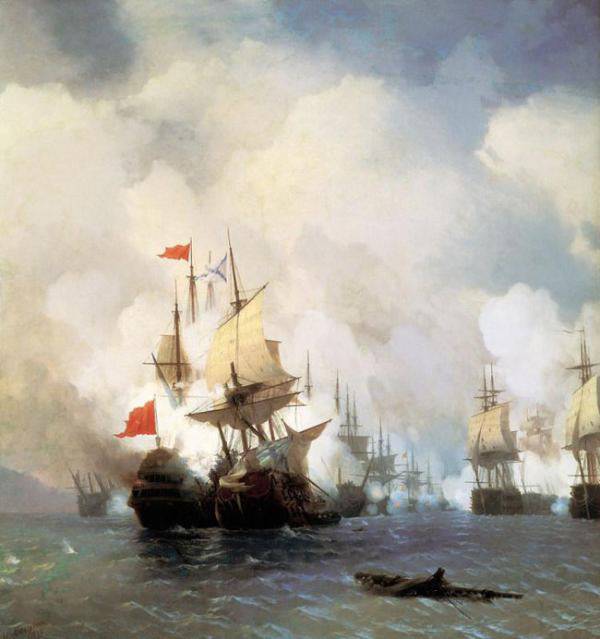
It would seem that the outcome of the battle was a foregone conclusion. But the battleship "Evstafy", which held the flag GA. Spiridov, was open to fire with the three most powerful Ottoman ships. This happened due to the fact that the first “Europe” that was going to start was demolished on stones. For the sailors “Eustafia”, demolished straight to the Turkish flagship, the “Real Mustafa” stop cannon, under the fierce fire of two more Ottoman ships, there was only one choice left: to die with honor. Flagships converged inevitably, firing at each other. G.A. Spiridov put on his parade uniform, prepared a pair of pistols, drew his sword, and ordered him to go up on the ute musician team, which he ordered: “Play to the last!”
The horrific crash of the sailing giants colliding with their sides momentarily drowned out the last march of the orchestra. In a fierce boarding battle, few noticed how the main-mast of Real Mustafa flared up. Someone from the Russian sailors cut her down and she collapsed with a flaming rigging across the linkage with him, “Evstafiy”. The strongest explosion of powder cellars blew both flagships.
Shortly before the fatal explosion, Spiridov managed to descend into the boat and sail through the boiling sea of fire. The squadron should not have been left without a commander. Captain "Evstafiya" A.I. Cruise until the last moment fought on the poop. His and another 60 man threw a blast into the water. More than 600 Russians and the 800 order of Turkish sailors died. Hassan Bey also met an explosion on the bridge. He was wounded, but rescued by lifeboats who came to his rescue from the shore.
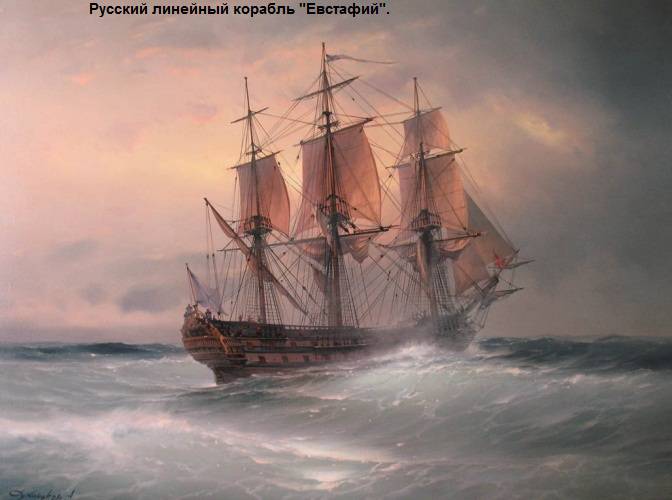
The battle lasted less than two hours. Boats picked up, according to eyewitnesses, and their own, and others. The loss of the flagship battleship and the serious wounds of Hasan Bey plunged the Turks into dismay. Kapudan Pasha was engaged in the feverish strengthening of the coastal batteries of the Chesmenskaya Bay. Powder barrels rolled out to the ships, which hastily loaded into the firefighters.
In the meantime, a council passed on the Russian squadron. Spiridov made a proposal: to attack and destroy the Turkish fleet, hiding in the Chesme Bay. The proposal was approved by all captains. To do this was entrusted to a group of four firefighters, which were to cover with fire all the other ships of the squadron.
With a complete consensus on the Russian squadron, a shock detachment was formed, which was headed by SK Greig as part of incendiary firefighters and covering ships. The determination and desire to "immediately go to work" was so great that even the desperate fighter and fatalist Alexei Orlov three times upset the heated captains during the council, demanding once again to recheck the disposition. It turned out to be the most difficult to choose commanders and sailors for the firefighters, since practically everyone, both officers and sailors, volunteered! At the same time, everyone realized that they had to go almost to certain death. After all, the incendiary vessel, in tow, behind a ten-boat dinghy, had to be brought close to the enemy ship and firmly hooked with hooks. Only after detonation of the charge on the fire brigade and the transfer of fire to the enemy, the team could descend into the boat and try to escape from the powerful explosion that could occur at any moment, from firing batteries - aliens and their own, because the covering ships opened fire on the enemy as soon as the brander grappled with the chosen goal.
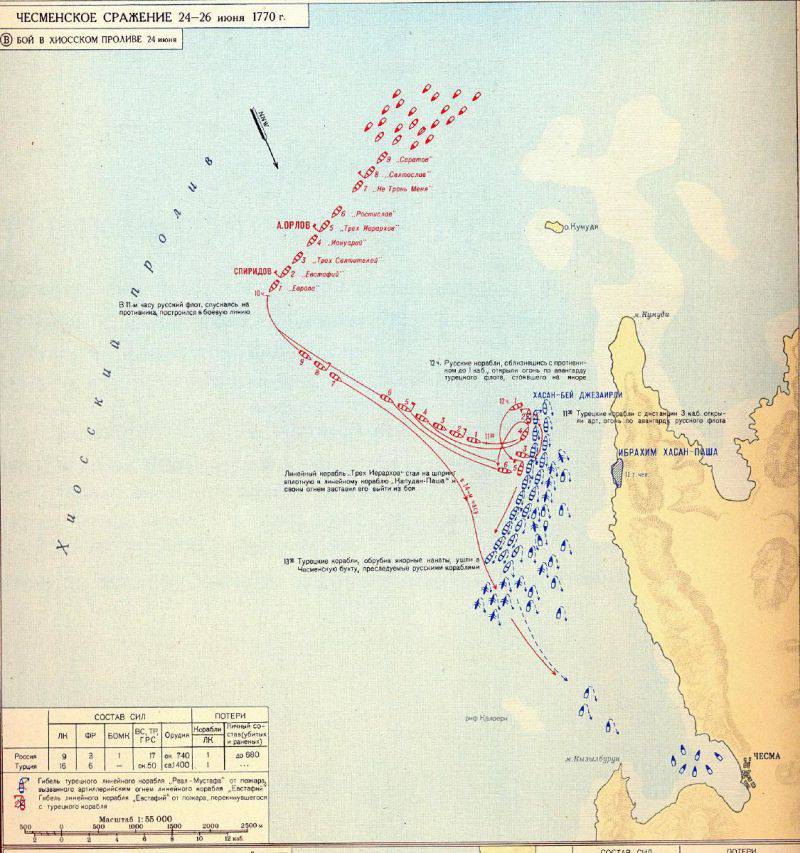
The last word remained for A.G. Orlov. This decision was one of those taken once in a lifetime. At stake was his own fate, the very existence of the squadron, and, as A.G. Orlov, "the whole European politician of Russia was at stake" - the authority of our country, which for the first time led the fleet into world waters. A man of exceptional personal courage, he was "horrified by what was coming," as he wrote in a report to the empress. Which is quite natural, because there were 15 Ottoman battleships, 6 frigates and many other ships and vessels on the roadstead of Chesma. In case of failure, this battle could be the last for our squadron. Especially if you take into account the preparation of the Turkish firefighters. Ways of a withdrawal to the Russian ships were practically cut off by a dozen of the large islands of the Chios Strait and Chesmenskaya Bay ...
Years later, Orlov wrote that neither the British, nor the French, nor the Venetians or Maltese, according to them, had ever imagined that they could attack the enemy with such patience and fearlessness, as Russian sailors did.
Night descended 26 June. The battleship "Europe", commanded by Captain F. Klokachev, an hour after midnight, with full sail rushed to the Turkish squadron, which was anchored tightly and randomly. He caused artillery fire on himself - mad, but not aimed. The enemy did not expect such a suicidal rush. “Is it possible to fight with the madmen,” the Ottoman chronicler tried to justify the confusion of his fleet with these words. However, this was not insanity, but a cold-blooded and accurate calculation and courage of the Russians.
Half an hour later, another three of our ships joined the “Europe”. And when, an hour later, the entire Russian squadron approached the neck of the bay, and the first Ottoman ships set on fire, set on fire with precise fire, glowing on the black surface of the bay with targets, the firemen rushed forward. Of the four goals achieved only one, Lieutenant D.S. Ilyin. He practically stuck to the board of the enemy 84-gun ship of the line and set fire to it. The extract of Ilyin and his crew was amazing, if, as an eyewitness recorded: “moving away from a burning wooden giant on a boat, he stopped to see what his action would be.”
By three o'clock in the morning the wind had completely subsided, completely depriving the Turkish sailboats of the possibility of any maneuver. By morning, the Chesme Bay was a sea of fire. Ottoman firefighters flared and exploded, which the Turks never had time to use, fire from burning sailing ships ran along the rigging and was transferred to still whole ships. S.K. Greig, recalled that the fire of the Turkish fleet was comprehensive. It is difficult to express in words the horror, daze and confusion that engulfed the Turks. The enemy has stopped any resistance, including on those ships that did not have a fire; most of the rowing ships either sank, or overturned by a large number of people leaping at them.
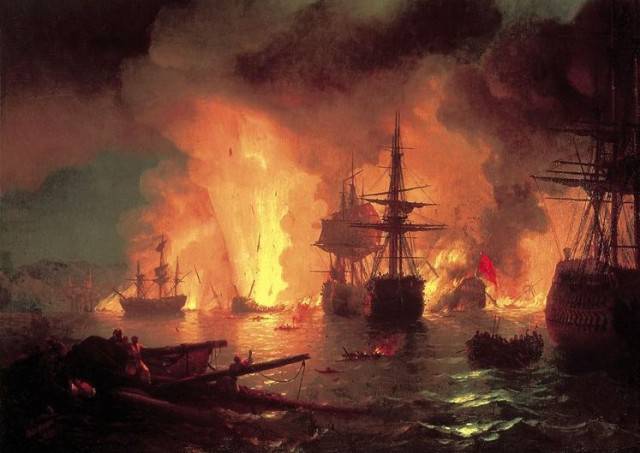
The population of Chesma and the nearest villages fled in panic from their homes. Western Turkey awaited with horror the invasion of Russian troops. Orlov really ordered the landing; encountering no resistance, our sailors marched through the burning city, where ammunition depots were torn. They took 19 copper Ottoman cannons and, as a kind of military trophy, a multitude of bales of silk fabrics from the state-owned sultan's manufactory. Then they returned to their ships. And the city order was maintained for two more days by a team specially sent by Orlov. “There was no discord and outrages, the wounded Turks were bandaged. Many were saved from the fire at risk,” reported AG. Orlov.
Russian sailors captured the Ottoman battleship Rhodes and five other war galleys as trophies. All other ships of the Turks burned. The fleet, which the Ottoman Empire was so famous for and proud of, ceased to exist. Sultan Mustafa III after Chesma fell ill and was dismissed. He died in the 1774 year, never recovering from the catastrophe of a military defeat that predetermined the Battle of Chesma. The triumph of the Russian fleet was complete.
G.A. Spiridov, assessing the results of Chesma, wrote to Petersburg that the Turkish fleet was sunk and turned to ashes, and the Russian fleet was now in the lead throughout the Archipelago. He further reported that the loss of ships in our squadron in this battle was not. Killed 11 people. While the Turks lost from 11000 to 12000 people.
The Russian sailors at Chios and Chesme were the first in the world to deviate from the patterns of linear tactics, at that time unshakable for the naval commanders of Europe and Turkey. The perfect interaction of the fire of ship cannons and firefighters during the night attack, the flotation art of G.А. Spiridova, S.K. Greig, A.I. Cruise, D.S. Ilyin and many other captains, multiplied by the mass heroism of the sailors, ensured a brilliant victory.
It is impossible not to note the outstanding role of the commander-in-chief of the expedition, A.G. Orlova, honestly deserving the title of Count Chesmensky. Assessing the situation, Orlov provided a tight blockade of the Dardanelles, which made it possible to cut off the Danube Ottoman army from the Greek and Eastern Mediterranean supply bases. Having captured here the essential forces of the Turkish army, he essentially helped our troops defeat the Turks on the Danube. Over 1771-1773 Russian fleet ships in the Archipelago intercepted more than 360 of the Turkish merchant ships that carried cargo in the interests of their army. The activity of the fleet, which managed to disrupt the enemy’s maritime communications, predetermined many glorious victories of the Russian ground forces. In 1774, Kyuchuk-Kaynardzhiy world was profitable for Russia and the entire Slavic world.
Chesma was followed by a three-year stay of the St. Andrew’s flag in Greek waters. The Greeks armed themselves, and most importantly, they believed in their own forces and no longer ceased armed struggle with the Turks, right up to the achievement of independence after the Russian-Turkish war of 1828-1829.
The amphibious operations of the Russian fleet to take Beirut in May 1772 and June 1773 had a more demonstrative than military character. Their goal was achieved: they helped the friendly sheikhs to believe that Russia does not leave allies. The Lebanese Druze received guns and weapons captured from the Turks, while Russians received several hundred thousand kurushes from the captured treasury of the local Turkish pasha, who went to the squadron’s salaries and foodstuffs. But A.G. At the same time, Orlov categorically rejected the request of the Lebanese emir Yusef Shahab, a Russian protectorate over Lebanon, which was besieged after Chesma with requests to accept him as Catherine the Second, as a “non-local” request.
Chesma marked a powerful and irreversible geopolitical breakthrough of the Russian state both in the West and in the East. At the same time, Russia sought not to expand its borders, but to strengthen them. Grateful contemporaries praised the heroism of the brave sons of the Fatherland. Hot on the heels of Catherine’s Park in Tsarskoye Selo, the genius Antonio Rinaldi erected three magnificent monuments to commemorate the victories of the Russian weapons. Two of them in memory of the Archipelago Expedition - Morey and Chesma Columns.
In the minds of Russians Navarin, Chios and Chesma were forever imprinted. The memory of these exploits inspired all subsequent generations of Russian sailors.
Sources:
Pronin A. The Pride of the Fatherland: Orlov-Chesmensky, Orlov-Decisive // Brother. 2005. No.9. C.32-37.
B. Galenin. On the 244 anniversary of the Battle of the Chesmen // Moscow Gazette. 8 July 2014.
Tarle E. The Chesmensky Battle and the first Russian expedition to the Archipelago (1769-1774). Reprint. SPb .: Galaxy, 1994. C.11-91.
Chernyshev A. The great battles of the Russian sailing fleet. M .: Yauza, 2010. C. 107-145.
Krinitsyn F. Chesme battle. M .: Voenizdat, 1962. C. 3-63.
Lebedev A. Chios and Chesma in the light of the data of the dummy journals of Russian battleships // Gangut. 2014. No. 81. C.31-38.
- Technical engineer
- Actions of the Russian fleet on the Lower Danube in 1877
Special tactics of Admiral Chichagov
Genius resolute offensive strategy
Suddenness in the tactics of Suvorov
The genius of the maneuver who beat Napoleon
Peter's reform of the Russian army
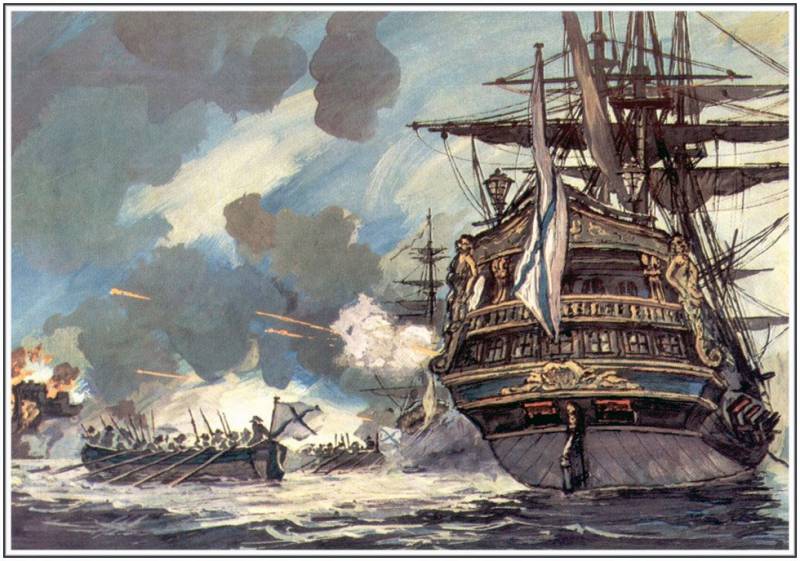
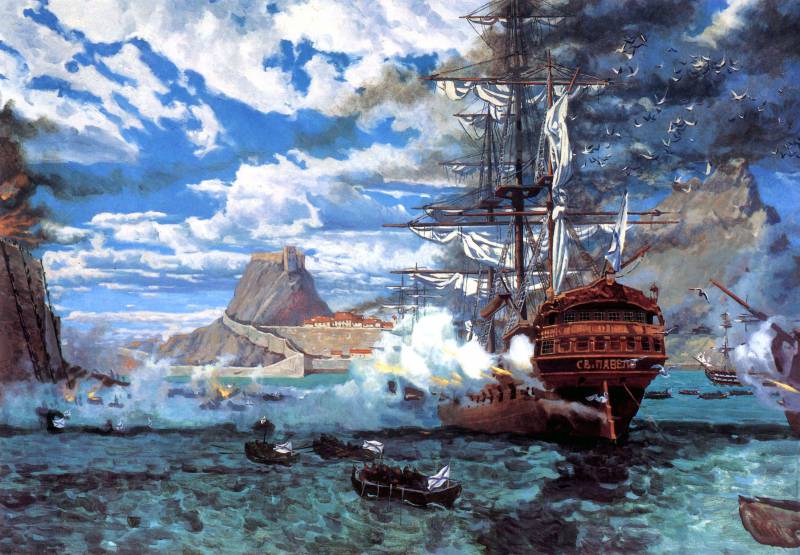
Information